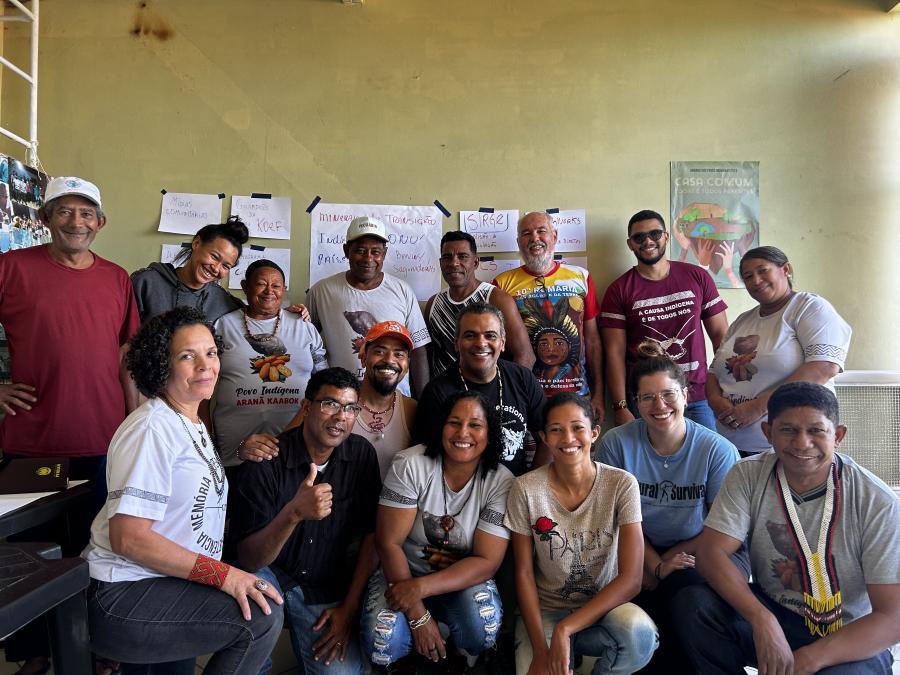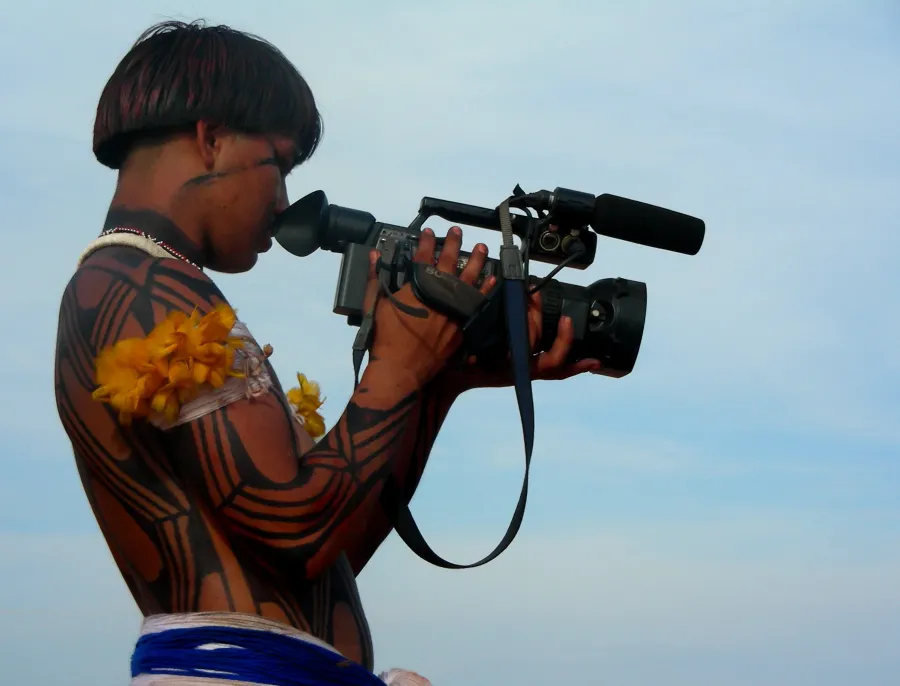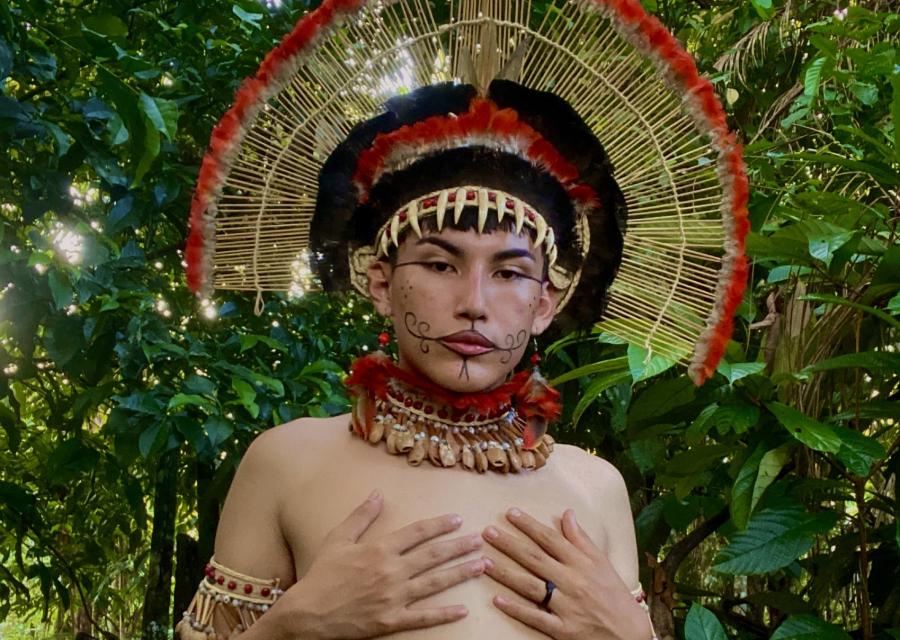In June 1992, indigenous peoples, environmentalists, activists, and heads of state gathered in Rio de Janeiro, Brazil for the Earth Summit and the Global Forum. The Earth Summit, officially called the United Nations Conference on Environment and Development (UNCED), brought together 118 heads of state, making it the largest summit meeting ever held. It was, "as promised, the most significant UN gathering since its inception in 1945," according to the U.S. Citizens Network Newsletter.
While official delegates finalized negotiations on environmental and development issues crucial to the world's future, the parallel NGO conference - Global Forum '92 - provided an opportunity for all sectors of civil society, from NGO's to indigenous people, to express their independent views. Combined attendance at the two conferences totaled well over 100,000, including individuals, non-governmental organizations, indigenous organizations, business and industry representatives. UNCED was able to put the environment on the agenda of 170 countries and "force all participants to consider the inextricable links between environment and development, between growth, consumption, poverty and environmental degradation," said the US Citizens Network Newsletter (July 1992). Five major documents were signed at UNCED: Agenda 21, a set of forest principles, a Biodiversity Convention, the Rio Declaration, and a convention on climate change.
The world's indigenous peoples prepared for UNCED as thoroughly and extensively as any state in the world. They organized their own preparatory conferences and also attended UN-sponsored ones, to establish a position at UNCED on par with any world nation. As Mary Simon of the Inuit Circumpolar Conference said at the Geneva Preparatory meeting, "Our points of view, concerns and expertise should be integrated into all the work of UNCED and not limited to issues identified as `indigenous.' Too often international policy and cooperation are perceived as the sole and sacred domain of national governments. Indigenous peoples are, however, very much aware of the existence in the world of various political philosophies, systems and governments."
The presence of indigenous peoples at UNCED and the Global Forum attempted to call the world's attention to their inherently profound and respectful relationship with the environment, and the concomitant destruction of this relationship due to human rights abuses. The networking at UNCED and Global Forum allowed indigenous peoples from all regions of the world to come together and share their problems, concerns, and history. "UNCED is a unique opportunity for all indigenous and non-indigenous peoples to reflect on the past, to evaluate the present and to plan a common future," Simon said.
Indigenous people were present at all levels of both events. Their level of organization achieved in the last several years and displayed at the Earth Summit attracted significant attention. "One of the positive outcomes of the UNCED was the successful effort of indigenous peoples to make environmental activists and policy makers recognize that grantees of indigenous rights must be a central component of efforts to solve the global environmental crisis," affirmed Robert Weismann of the Multinational Monitor.
The most ambitious international governmental document was the sustainable development action plan, Agenda 21, covering all areas of the world where environment and development intersect and major social groups are affected. Its proposals are divided into four sections, 40 chapters and more than 100 programs. The third section, "Strengthening the Role of Major Groups," is the most extensive and formalized recognition in a UN document of indigenous peoples, incorporating the rights and responsibilities of indigenous peoples and their communities into national legislation. Indigenous peoples were especially successful in incorporating their knowledge and concerns into the sections on biodiversity and the management of forest and ocean resources.
"The Agenda 21 text on Indigenous People and Their Communities recognizes the `holistic tradition of scientific knowledge of their lands, natural resources and environment' of indigenous groups who represent a significant percentage of the global population. The text also refers to economic, social and historical factors which have hindered indigenous peoples' `ability to participate fully in sustainable development practices on their lands' and advocates that they `shall enjoy the full measure of human rights and fundamental freedoms without hindrance of discrimination.' (E and D File, 1992 July No. 29, NGLS)
The conference provided a global forum for discussing human rights problems and implementing human rights doctrines in a world document. Two years after UNCED, Agenda 21 has been used to help indigenous peoples in a number of ways.
The Lummi Nation has invoked it in an effort to preserve the cultural heritage of the old growth forest in the Pacific Northwest. This action was possible because of the Earth Summit, where the Lummi Nation made contact with a filmmaker. The result, six months after the conference, was a film on the Lummi Nation's efforts to preserve the ancient forests in Washington State. PBS broadcast the documentary nationwide to millions of viewers the evening before Earth Day '93. "This has greatly helped our efforts to secure protection for the forests. Once again, there would not have been a film had there been on Earth Summit," said Iurt Russo of the Lummi's Treaty Task Force.
A conference called "Speaking For The Earth: Building an Indigenous Network for Sustainable Development", scheduled to meet in New York this May, was organized by the Lummi Nation to bring together traditional indigenous leaders with representatives of national and international assistance organizations. It will provide a forum to exchange experience and information to assist tribal communities in preserving and protecting their cultural traditions, lifeways and the environment. And the native representatives will have an opportunity to respond to two critical UN initiatives: Agenda 21 and the Sustainable Development Commission.
Radio Amazonia, a Friends of the Earth project, came to prominence in Global Forum '92. The project installs radio transceivers equipped with solar generators into isolated areas of the Amazon region, to strengthen the capacity to protect indigenous control over the land and provide health assistance to indigenous communities and other forest dwellers. Representatives of the Ticunas have recently informed FOE (Friends of the Earth) that no cholera casualties have been recorded so far among the Ticunas, while dozens of people have died in other villages not equipped with the radio stations. Since the project has been highly successful in the Western Amazon, there is talk of expanding the network throughout the Amazon, Eighty new station sites have already been identified for the radio transceivers.
The Shuswap Nation Tribal Council and the Assembly of First Nations are organizing an Inter-American Indigenous Program to implement the Biodiversity Convention on indigenous lands in the Americas. This program would develop ways for indigenous peoples throughout the Americas to implement the Biodiversity Convention and Agenda 21 on their lands, using traditional knowledge and practice to recuperate damaged lands, protect those still intact and adapt economies of sustainable use.
Article copyright Cultural Survival, Inc.



